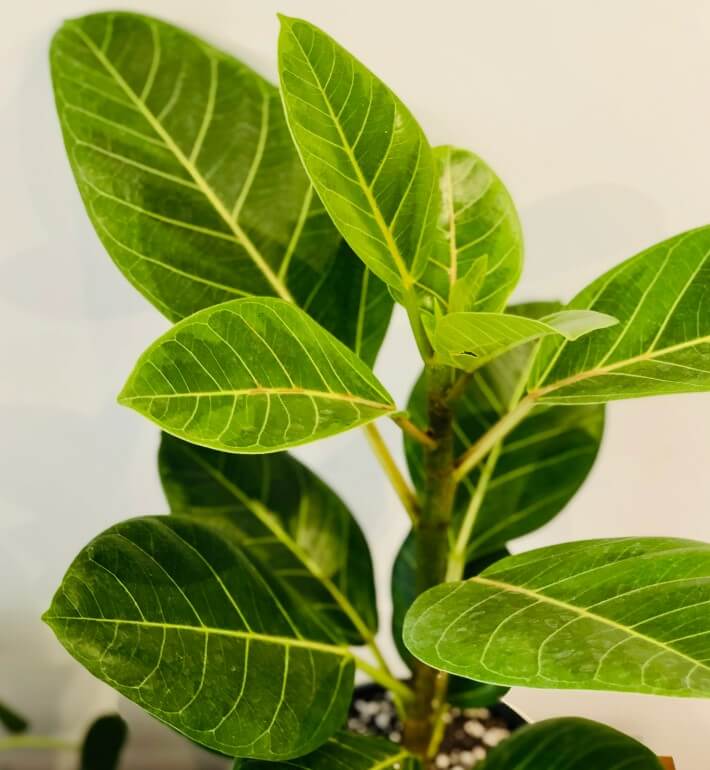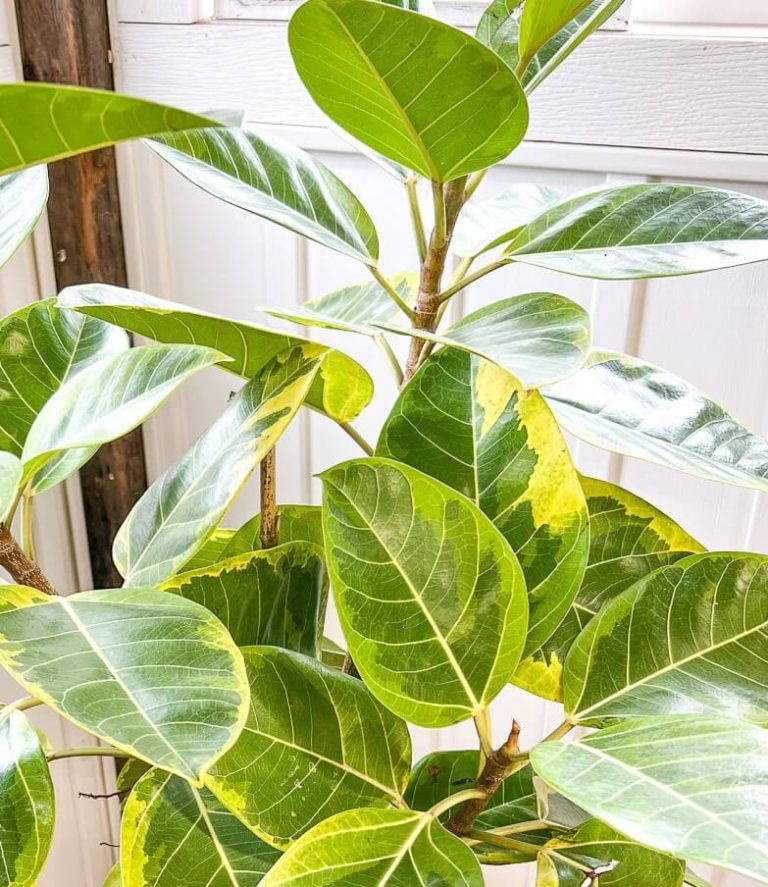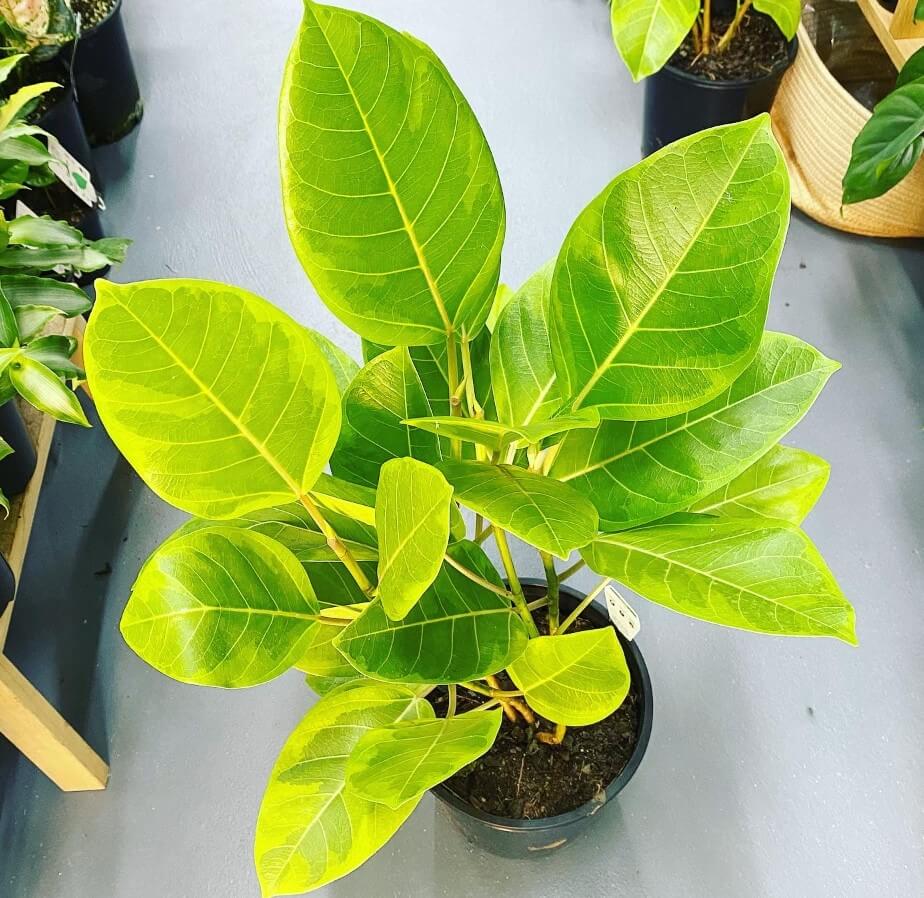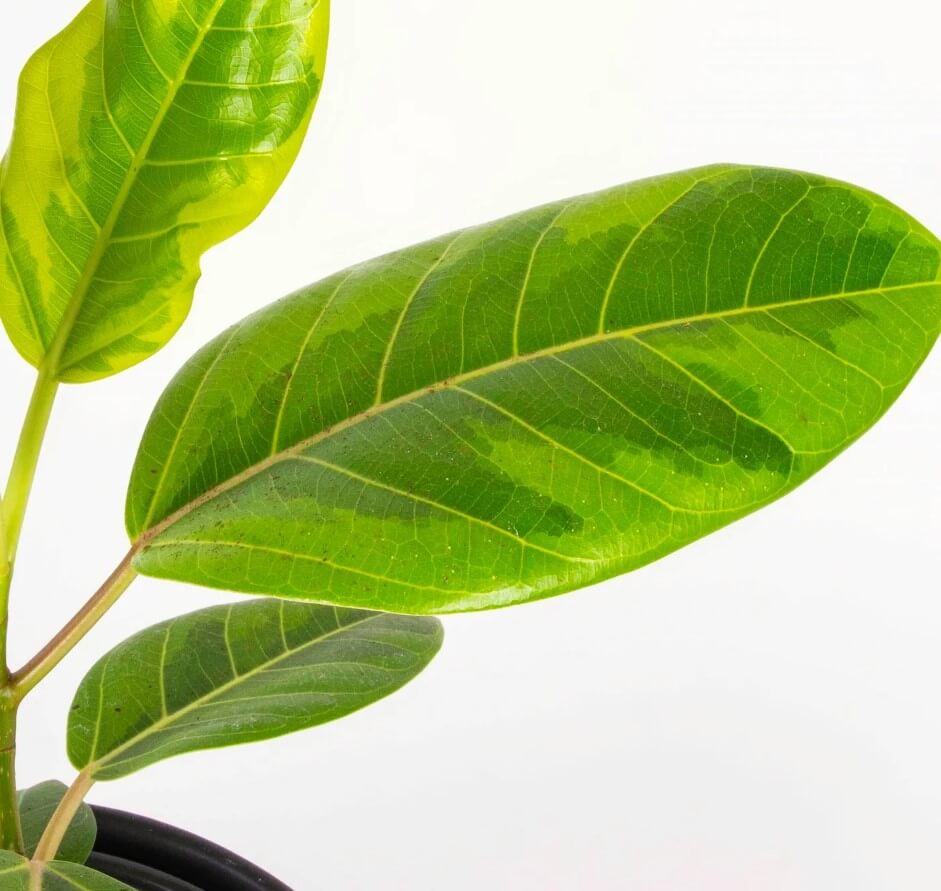The Ficus Altissima Yellow Gem is a popular houseplant beloved for its bushy shape and bright, golden-yellow and green variegated leaves. This plant is native to the rainforests of Southeast Asia and is also known as the Golden Gem Ficus.
With the proper care, the Ficus Altissima Yellow Gem can thrive indoors, bringing a cheerful pop of color into any space. This plant requires bright, indirect light and consistent watering to look its best. Pruning is also beneficial to keep the plant full and bushy.
This comprehensive guide will cover everything you need to know about successfully growing the Ficus Altissima Yellow Gem indoors, including details on lighting, watering, fertilizing, pruning, propagation, troubleshooting problems, and more tips for optimal care.
Key Takeaway
| Topic | Key Points |
|---|---|
| Light Requirements | – Moderate to bright indirect light – South, west, or east facing windows ideal – Use sheer curtains to filter direct sun – Supplement with grow lights if needed |
| Watering | – Allow soil to partly dry out between waterings – Water when top 1-2″ of soil is dry – Water thoroughly until excess drains out – Don’t let sit in water, leads to root rot |
| Soil | – Loose, well-draining potting mix – Amend soil with perlite or bark to improve drainage – Repot every 2-3 years to refresh soil |
| Fertilizer | – Use balanced liquid fertilizer at half strength every 2-3 weeks in spring/summer – Reduce feeding in fall/winter – Avoid over-fertilizing |
| Pruning | – Prune to shape plant and encourage bushy growth – Prune back leggy stems and dead branches – Can remove up to 1/3 of plant at a time |
| Propagation | – Take 5-6″ stem tip cuttings in spring/summer – Remove lower leaves, dip in rooting hormone – Plant in potting mix, provide humidity – New roots/growth in 3-8 weeks |
| Repotting | – Repot every 2-3 years in the spring – Move to pot 1 size larger – Loosen roots, trim damaged ones – Set root ball 1″ below rim, water well |
| Problems | – Leaf drop, spots from improper watering or light – Mealybugs – wipe away with alcohol – Root rot from overwatering – repot in fresh soil |
| Care Tips | – Consistent watering and fertilizing – Regular pruning – Rotate plant for even light exposure – Keep away from drafts and vents – Wipe leaves, provide humidity |
Light Requirements
The Ficus Altissima Yellow Gem thrives in moderate to bright indirect sunlight. Direct sun will scorch the leaves, causing yellowing or browning.
Some ideal places to situate this plant include:
- Next to a south or west facing window. Use sheer curtains to filter the light.
- Under a canopy of taller houseplants that provide dappled shade.
- Near an east facing window but not in direct morning sun.
If natural light in your home is less than ideal, providing supplemental artificial lighting can help the plant flourish. Use full spectrum LED grow lights for 12-14 hours per day.
Signs that your Yellow Gem Ficus is getting insufficient light include:
- Fewer bright yellow leaves. Existing yellow leaves may fade to green.
- Leggy or stretched out growth.
- Smaller than usual leaf size.
- Sparse foliage and bare stems.
Adjusting the lighting and providing brighter conditions without direct sun will help the plant regain its vibrant foliage. Rotate the pot periodically so all sides get adequate light exposure.
Here is the next section on watering the Ficus Altissima Yellow Gem:
Watering Your Yellow Gem Ficus
Establishing the right watering routine is key to keeping your Ficus Altissima Yellow Gem healthy. This plant prefers soil that is allowed to partially dry out between waterings.
Some tips for watering:
- Check the soil by inserting your finger 1-2 inches deep. Water when the top inch feels dry.
- Water thoroughly until excess drains from the bottom drainage holes. This ensures the entire root zone receives moisture.
- Don’t allow the plant to sit in water for prolonged periods, as this can lead to root rot. Remove any drainage saucer after 30 minutes.
- Water less frequently in winter when growth slows. The plant may only need water every 2-3 weeks.
Signs of underwatering include:
- Dry, drooping leaves that may turn yellow or brown at the edges.
- Soil pulls away from the sides of the pot.
- Stunted new growth.
Overwatering causes:
- Yellow, translucent leaves.
- Mushy stems.
- Leaf drop.
- Root rot – foul odor, soft black roots.
If you notice any signs of underwatering, give the plant a good, thorough soak. For overwatering, let the soil dry out completely before watering again. You may need to repot in fresh, dry soil.
The Ficus Altissima enjoys average room humidity around 50-60%. Use a pebble tray or humidifier nearby or mist the leaves occasionally to provide a humidity boost.
Here is the next section covering soil needs for the Ficus Altissima Yellow Gem:

Soil Needs
Using the proper potting mix is important for the health of your Ficus Altissima Yellow Gem. This plant thrives in a loose, well-draining soil.
Here are some tips for choosing the right soil:
- Use a general purpose potting mix, not garden soil which is too heavy. Look for a mix containing peat moss, perlite, bark chips or coco coir.
- To improve drainage, amend regular potting soil with perlite, pumice, or orchid bark in a ratio of 1 part amendment to 2 parts soil.
- Soilless mixes like peat-perlite or peat-vermiculite also work well. They drain faster than standard potting mix.
- Ficus prefer slightly acidic soil in the pH range of 6.0-6.5. Test with a soil pH kit.
- Re-pot every 2-3 years in the spring to refresh the potting mix. Use a container only 1 size larger.
When re-potting, carefully remove the root ball from the old pot. Gently loosen any circled roots before placing the plant in the new container filled with fresh soil.
Providing the right soil encourages healthy root growth and prevents issues like root rot due to excess moisture. Let the soil dry out partially between waterings.
Here is the section on fertilizing the Ficus Altissima Yellow Gem:
Fertilizer
Applying fertilizer at the right times provides nutrients to support an actively growing Ficus Altissima Yellow Gem. These plants are light feeders and only need occasional, diluted application of fertilizer.
Some tips for fertilizing:
- Use a balanced liquid houseplant fertilizer diluted to half strength. Fertilize every 2-3 weeks during the spring and summer months.
- In fall and winter, reduce fertilizing to once a month or stop completely. Growth slows during this time.
- Apply slow release pellet fertilizer in spring to provide nutrients over 3-4 months. Follow package directions.
- If the plant shows signs of stress like yellowing leaves or after repotting, wait a few weeks before fertilizing again.
- Flush the soil occasionally with fresh water to prevent buildup of mineral salts from fertilizer.
- Mist the leaves after fertilizing to rinse away any residue.
Avoid over-fertilizing which can cause leaf burn or root damage. If using a general purpose fertilizer, look for a balanced formula indicating equal amounts of nitrogen, phosphorus, and potassium.
Providing the right amount of fertilizer at the proper times prevents nutrient deficiencies while encouraging lush, vibrant growth.
Here is the section on pruning and propagating the Ficus Altissima Yellow Gem:
Pruning Your Ficus
Pruning is an essential part of caring for a Ficus Altissima Yellow Gem. Regular pruning encourages bushy, full growth and maintains the desired size and shape.
Follow these tips when pruning:
- Use clean, sharp pruners or scissors to make cuts. Sterilize tools with isopropyl alcohol.
- Prune back any leggy stems to encourage branching and fullness.
- Trim off any dead or damaged branches or leaves. Also prune away yellow leaves.
- Pinch or cut back new growth to shape the plant and create a bushy form.
- Remove up to 1/3 of the plant can be removed at one time. Avoid over-pruning.
- Make cuts just above nodes or leaf joints. New branches and leaves will emerge from nodes.
- Prune in late winter or early spring as growth resumes. Can also trim anytime growth becomes unruly.
Propagating Yellow Gem Ficus
The Ficus Altissima Yellow Gem can be easily propagated by stem cuttings. Taking cuttings in spring or summer has the best success rate.
Follow these steps:
- Use a healthy mother plant and take 5-6 inch stem tip cuttings.
- Remove the lowest leaves and dip the cut end in rooting hormone powder/gel.
- Plant the cuttings in small pots filled with moist potting mix.
- Cover with plastic wrap to maintain humidity. Keep soil moderately moist.
- New roots and leaves should develop in 3-8 weeks. Gradually expose to normal conditions.
- Once established, transplant to a regular potting mix and treat like an adult plant.
Propagating provides an easy way to create new Yellow Gem Ficus plants identical to the parent. Give new plants plenty of bright, indirect light to encourage lush growth.
Here is the section covering repotting:
Repotting
The Ficus Altissima Yellow Gem should be repotted every 2-3 years in the spring to provide fresh soil and allow room for growth.
Follow these tips when repotting:
- Choose a new container one size larger than the current pot. Ficus Altissima prefer being slightly root bound.
- Carefully remove the plant from its pot and loosen any circled or dense roots. Trim off any damaged roots.
- Place the plant in the new pot filled with fresh, well-draining potting mix appropriate for Ficus.
- Check that the root ball sits about 1 inch below the rim of the container.
- Fill in around the roots with soil, tamping to remove air pockets.
- Water well after repotting and allow it to drain completely.
- Leaves may drop after repotting while the plant adjusts. Normal growth will resume in a few weeks.
Repotting in a larger container gives the plant room for growth and refreshed soil provides essential nutrients.
Here are the final sections covering troubleshooting common problems and tips for optimal Ficus Altissima Yellow Gem care:
Troubleshooting Common Problems
Even with proper care, Ficus plants can sometimes develop issues. Here are some common Ficus Altissima problems and potential solutions:
- Leaf drop – Caused by overwatering, underwatering, or stress. Adjust watering practices and allow soil to partly dry before watering again.
- Leaf spots – Can be a sign of bacterial or fungal infection. Prune affected leaves. Improve air circulation and avoid wetting leaves.
- Mealybugs – Cottony white insects on leaves and stems. Wipe away with cotton swab dipped in alcohol or use insecticidal soap.
- Root rot – Caused by overwatering or poor drainage. Repot in fresh, dry soil and don’t water again until dry.
- Leaf yellowing – From too much or too little water or insufficient light. Adjust watering or move plant to better lighting conditions.
Tips for Optimal Ficus Altissima Care
Follow these tips to keep your Ficus Altissima Yellow Gem thriving:
- Provide consistent watering, allowing the soil to partly dry out between waterings.
- Fertilize regularly during spring and summer to support growth.
- Prune back unruly growth and any dead/damaged branches to improve shape.
- Keep plant away from cold drafts and heating vents to prevent leaf damage.
- Rotate the pot periodically to ensure even light exposure and growth.
- Wipe leaves occasionally with a damp cloth to remove dust buildup.
- Mist leaves or use a pebble tray to provide extra humidity.
FAQ
Q: How to variegate my ficus altissima yellow gem plant?
A: The variegated yellow and light green leaves of the ficus altissima yellow gem are a natural characteristic of the plant type and not something that can be created or enhanced by the grower. Variegation levels can vary with different factors like light exposure and overall plant health. Keep the plant under full sun or bright, indirect light to highlight the variegation.
Q: What are the care tips for ficus plants particularly the altissima yellow gem?
A: The care tips for a altissima yellow gem include keeping the plant indoors as it is an indoor plant, maintaining moderate humidity levels, and ensuring the soil is kept moist but not soggy. You should also protect it from draughts and move the plant to brighter light if the variegation of the leaves starts to fade.
Q: What is the difference between ficus audrey and altissima yellow gem?
A: While both types of ficus trees are indoor tropical plants, the main differences lie in their appearances. Ficus audrey has large, dark green leaves, while the altissima yellow gem has bright green to dark green leaves with variegated yellow patches. Additionally, the Audrey is often compared to the fiddle leaf or ficus elastica, whereas the Yellow Gem relates more to a variegated rubber tree or Asian Council Tree.
Q: When and how to fertilize my altissima yellow gem?
A: The altissima yellow gem should be fertilized during the growing season, usually from late spring to early fall. Use a balanced houseplant fertilizer and follow the package instructions. Always water the plant before fertilizing to prevent root burn and remember to never fertilize a dry plant as this can harm the roots.
Q: Why are the leaves of my altissima yellow gem turning dark green?
A: If your variegated yellow and light green altissima yellow gem is turning dark green, it may be due to lack of light exposure. These plants need full sun or bright, indirect light to maintain their variegation. If it’s not getting enough light, leaves may turn more green.
Q: Can I plant my altissima yellow gem outdoors?
A: While the altissima yellow gem is a tropical type of plant that can be adaptable to different conditions, it generally thrives better as indoor plants. If planted outdoors, it will need a sheltered spot with indirect light, well-draining soil, and protection from harsh weather conditions.
Q: How often should I water my altissima yellow gem?
A: The altissima yellow gem prefers to keep the soil moist but not waterlogged. Wait until the top 2 inches of soil are dry before giving it a thorough watering. Remove any excess water from the saucer to prevent root rot. Adjust the watering routine depending on the season and the plant’s growth phase.
Q: Are ficus plants like altissima yellow gem easy care indoor plants?
A: Yes, the altissima yellow gem, like most ficus plants, is considered an easy care indoor plant. With proper care, which includes balanced watering, sufficient indirect sunlight, and occasional fertilization, these plants can thrive indoors for many years.
Q: Can you ship the altissima yellow gem or other ficus plants?
A: Yes, many plant retailers and nurseries are able to ship the altissima yellow gem and other ficus trees. However, it’s important to note that the arrival condition can vary depending on many factors including shipping duration, handling care, and weather.
Q: How to manage sap from the altissima yellow gem and other ficus trees?
A: Ficus trees including altissima yellow gem can exude a sticky sap if stressed or damaged. This sap can be irritating to the skin and eyes. You can clean the sap with mild soapy water or by using an insecticidal soap if you find it has been populated by mealybugs, which can break up the mealybug life cycle.


